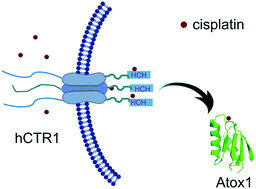Platinum transfer from hCTR1 to Atox1 is dependent on the type of platinum complex†
Abstract
In spite of their wide application, the cellular uptake of platinum based anticancer drugs is still unclear. The copper transport protein, hCTR1, is proposed to facilitate the cellular uptake of cisplatin, whereas organic cation transport (OCT) is more important for oxaliplatin. It has been reported that both N-terminal and C-terminal metal binding motifs of hCTR1 are highly reactive to cisplatin, which is the initial step of protein assisted cellular uptake of cisplatin. It is still unknown how the platinum drugs in hCTR1 transfer to cytoplasmic media, and whether various platinum complexes possess different activities in this process. Herein, we investigated the reaction of the platinated C-terminal metal binding motif of hCTR1 (C8) with the down-stream protein Atox1. Results show that Atox1 is highly reactive to the platinated C8 adducts of cisplatin and transplatin, whereas the oxaliplatin/C8 adduct is much less reactive. The platinum transfer from C8 to Atox1 occurs in the reaction, which results in the protein unfolding of Atox1. These results demonstrated that the platinated intracellular-domain of hCTR1 is reactive to Atox1, and the reactivity is dependent on the ligand and the coordination structure of platinum complexes. The different reactivity is consistent with the hypothesis that hCTR1 is more significant in the transport of cisplatin than that of oxaliplatin.



 Please wait while we load your content...
Please wait while we load your content...